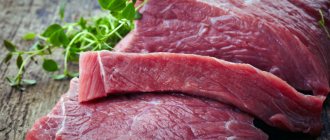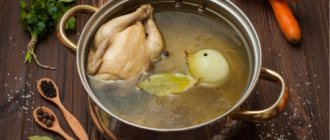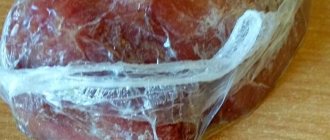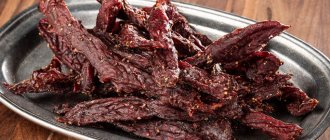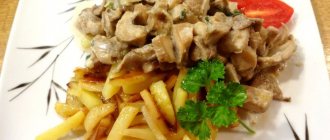Cooking meat seems simple. In fact, complex transformation processes take place in the pan. When meat is heated to 40°C, the protein that makes up the muscle fibers begins to shrink (a process called denaturation) and the flesh becomes denser. The collagen contained between the fibers is also converted into glutin, which makes the finished meat juicy. When all the collagen is converted into a clear liquid without blood impurities, the product can be considered ready. It is important not to overcook the meat so as not to destroy the vitamins and nutrients contained in it.
How to choose a product
The taste and organoleptic qualities of boiled beef depend on the quality of the raw materials. Choosing good meat is not difficult if you know six criteria.
- Color. Quality meat should be light red in color. If the beef is burgundy, brown, or a combination of several shades, it is most likely stale. The veins should be white, but under no circumstances yellow.
- Smell. The beef should have a pleasant, fresh, sweetish aroma. If your sense of smell detects even the slightest unpleasant notes, refuse to purchase. You need to smell the meat not only from above, but also in the cut.
- Tactile sensations. Touch the meat - your fingers should not stick. And after this, the skin should remain dry, without traces of mucus.
- Surface. It should be shiny and uniform, without spots or crusts. Only slight weathering of the surface of the meat is acceptable if it is sold from an open counter.
- Elasticity. Use your finger to press down on the piece of beef with a little force. The resulting dent should quickly return to its original state.
- Part. The most tender and juicy meat will be from the shoulder blades, sternum or back. If you are going to cook the broth, choose drumsticks or neck. It is good to use ribs for soup - they give a good fat.
There is little chance of buying good beef in a store or supermarket. Under the guise of local fresh meat, they often sell defrosted imported products. It is better to buy beef from farmers at the market. Do not hesitate to ask the seller for a veterinary certificate to ensure the quality and safety of the product.
How long to cook beef
Professional chefs and experienced housewives say that you need to cook beef for at least two hours to make it soft and tender. This time is also enough to kill parasites that can live in raw meat. There are also five factors that determine how long to cook beef. The time is counted after the water boils.
- Age of the animal. Old meat is tough and requires long cooking (at least three hours). A large piece of veal can be cooked in 40 minutes.
- Personal preferences. If you like to chew meat and feel its taste and texture, two hours of cooking will be enough. And if you want your food to melt in your mouth, you will have to spend more time cooking.
- Purpose. You need to cook the beef for the soup for at least an hour. During this time you will get a delicious aromatic broth. Cooking the piece of meat itself can be completed in a separate pan or in the same one. This will make the broth richer.
- Piece size. A large piece will cook for at least two hours. If you divide the meat into several smaller pieces or use entrecote, 40-60 minutes will be enough. It will take about an hour and a half to cook beef with a bone (for example, for soup).
- Fat content. “Marbled” beef with many layers of fat cooks almost twice as fast as regular meat with a dense fiber texture.
If the meat has been cooking for a long time, but you are not sure whether you can turn off the burner, check the readiness of the product experimentally. Pierce the beef with a fork or knife and lift it over the pan. If the product slides off the tip easily, it is ready. Otherwise, the meat will have to be cooked for some more time.
4 defrosting methods
Frozen beef needs to be cooked for the same amount of time as fresh beef. It is only important that the meat is completely thawed before cooking. Otherwise, the product will take longer to cook and will not cook evenly. To bring the product to the desired condition, you can use one of four proven techniques.
- In water. Frozen meat should be placed in a bag and placed in a container filled with water. The liquid should be cold or slightly warm. In an hour you can start cooking.
- In the microwave. Place the meat in the oven and turn on the “Defrost” mode. If your microwave does not have this function, simply turn on the device at minimum power. The product will thaw in a few minutes.
- In a refrigerator. Remove the meat from the freezer and move it to the bottom shelf of the refrigerator. The beef will defrost for at least a day, but it will better retain its structure and nutrients.
- At room temperature. Place the meat in a bowl and leave on the counter for three to four hours.
Cooking rules
In addition to taking into account the category and type of meat, the time depends on the desired dish. There are cooking rules that affect this:
- For a rich broth, the time must be increased to 2 hours. Therefore, the meat is sent not to boiling water, but to cold water.
Tip: meat that has a larger number of tendons is suitable for broth - category II (grades 2 - 3). It's better to cook it whole. It’s good to add salt at the beginning, this will create richness and flavor.
- To reduce the loss of beneficial qualities and time, meat should be cooked immediately in boiling water.
Tip: the prepared (thawed and washed) piece of beef is placed in a pan slightly larger than the piece itself. Then it, cooked in a small volume of water, will acquire a very delicate taste. After the water boils, reduce the heat to low and do not open the lid. Add salt here at the end of cooking, about 10 minutes before completion.
- To make the meat cook faster, large pieces are cut along the grain.
- Many cooks fry the beef before cooking it in butter with salt and seasonings until lightly browned. Then cook, skimming off the foam, over low heat for 3 hours. The beef becomes soft and tasty.
Basic cooking methods
Boiling is the most common and rather primitive method of cooking. But the development of technology, as well as the imagination of cooks and housewives, has long taken this process beyond the scope of pots and cauldrons. Depending on your technical capabilities and taste preferences, choose the best method for yourself.
In a saucepan
Peculiarities. In ancient times in Rus', beef was simmered in a cast iron pot for several hours. The meat turned out tender and soft. There was still a rich broth left, from which it was possible to cook a hearty stew. Therefore, if you have a cast iron pan, choose it for cooking beef. An enamel pan with a thick bottom will also work. Take a large container that will fit the entire piece of meat.
How to do
- Place the pan with meat and water on the stove and turn the heat to maximum.
- As soon as the water boils, turn on the burner. The fire should be low so that the water only bubbles slightly.
- Skim off the foam.
- Salt the meat. You can determine the amount of salt at your discretion. Standard - a tablespoon per 0.5 kg of meat and 2 liters of water.
- Cover the pan with a lid and cook the meat for an hour.
- Check the meat for doneness. If it can be easily pierced with a knife or fork, you can remove the pan from the stove. If the beef is tough, cook for another 30 minutes.
- Transfer the finished meat from the pan to a separate dish to allow the product to cool.
If you plan to cook soup based on beef broth, you need to strain it. It is possible that there may be small bones or foam residues in it.
In a slow cooker
Peculiarities. Multicookers have become a part of kitchen everyday life. A compact, elegant device can replace a saucepan, a frying pan, and even an oven. Cooking in it is a pleasure. Beef from a slow cooker turns out especially flavorful and tender. And most importantly, the device itself will determine the temperature required for cooking.
How to do
- Place the meat in a bowl, add water and turn on the “Cooking” or “Stewing/Soup” mode without closing the lid.
- After boiling, skim off the foam, add salt and close the lid.
- Continue cooking the meat as usual for an hour.
- Try piercing the beef with a fork. If the meat gives in easily, it is ready. If not, you need to cook for another 30 minutes.
In a steamer
Peculiarities. If you follow a healthy lifestyle or want to lose weight, steam the meat. This method allows you to preserve the structure and taste of meat as much as possible, and most importantly, the vitamins, minerals and trace elements that it contains.
How to do
- Cut the meat into small portions no more than 1 cm thick and add salt.
- Place the workpiece in a container. It is better to lay out the meat in one layer.
- Turn on the device and cook the beef for an hour.
- Turn the meat over and cook for another 30 minutes.
In a pressure cooker
Peculiarities. The only way to quickly cook a large piece of red meat is in a pressure cooker. The secret of the device lies in the hermetically sealed lid. The specific design provides increased pressure inside the pan, due to which the boiling point increases. This allows you to reduce the cooking time of meat by two to three times compared to a conventional pan and other kitchen appliances.
How to do
- Place the meat in a pressure cooker and add water. The liquid should completely cover the product.
- Place the pressure cooker on high heat until the water boils.
- Skim the broth and add salt.
- Reduce heat, cover the pressure cooker with a lid and cook the meat for another 50 minutes.
It is important to correctly determine the amount of water. If you cook meat for soup, it is important that there is a lot of broth and that it is not too concentrated. If boiled beef goes into a salad or is a separate dish, it is enough for the liquid to cover the meat by 1 cm.
In the microwave
Peculiarities. As a rule, a microwave oven is used for such basic processes as defrosting and heating food. But this is not all that a kitchen appliance is capable of. It is quite possible to cook full meals in it.
How to do
- Place the meat in a deep microwave-safe bowl.
- Pour boiling water over the beef, add salt and seasonings.
- Place the container in the microwave and heat on medium power for 20 minutes.
- Cover the bowl with a lid (it should also be microwave safe) and turn the power to low.
- Check the meat for doneness every 20-30 minutes.
In film
Peculiarities. People prefer to eat fried, baked, stewed, but not boiled meat. And all because during cooking the product “gives” part of its taste and aroma to the water. The problem can be solved by boiling beef in its own juice.
How to do
- Salt, season the washed meat and wrap tightly in several layers of cling film or place in a baking sleeve.
- Place the workpiece in a pan filled with cold water.
- Cook the product at maximum burner power until it boils, then reduce the heat so that the water is only slightly bubbling.
- In this mode, the meat needs to be cooked for two hours.
When you cut the film, in addition to the meat, it will contain a fragrant concentrated broth. It can be used to make sauces or added as a gravy to side dishes.
In the microwave
You can use a microwave oven to cook beef if the meat is young. The process is:
- Cut the prepared product into portions.
- To speed up cooking, it is recommended to pound the meat with a hammer.
- Rub in salt and spices.
- Place in a baking bag and seal. Place it in a deep microwave-safe bowl.
- Pierce a couple of times with a knife.
- Place in the oven. Cook on medium power for 20-30 minutes.
- Leave for 10 minutes and check readiness.
- If necessary, cook for another 10-20 minutes.
Interesting recipes
If you think that boiled beef is a boring and bland diet food, then you are deeply mistaken. If you experiment a little with the ingredients, you can end up with a flavorful dish that will diversify your everyday menu and even decorate your holiday table.
With mushrooms and tomato
Peculiarities. Beef and mushrooms are an almost perfect combination. Bright flavors and contrasting textures combine seamlessly in delicious dishes. And the tomato will add a piquant sourness to the dish, which will successfully dilute the combination of rich aromas.
You will need:
- 1 kg beef;
- three large champignons;
- large tomato;
- five black peppercorns;
- Bay leaf;
- a quarter glass of cognac;
- a tablespoon of salt.
Preparation
- Place the meat in a saucepan of cold water. The liquid should cover the product by 2 cm.
- Cook over high heat until the liquid boils, then skim off the foam.
- Reduce heat and simmer meat for an hour.
- Meanwhile, peel and finely chop the mushrooms and tomatoes. Place in the pan with the meat.
- Add spices and cognac and cook for another two hours.
- At this stage, you need to add salt to the broth and cook the beef for another ten minutes until tender.
- Cut the meat into portions, and the broth can be used for a delicious soup.
Spiced
Peculiarities. Beef “loves” spices. In the sense that it readily absorbs the aromas of spices, acquiring an even richer taste. Spices also help soften the fibers, which, combined with cooking, makes the beef incredibly tender.
You will need:
- 1 kg beef;
- carrot;
- bulb;
- parsley or celery root;
- four cloves of garlic;
- three tablespoons of adjika;
- a bunch of greens (basil or cilantro);
- five black peppercorns;
- a tablespoon of salt.
Preparation
- Place the meat in a pan of water and place over high heat.
- Coarsely chop the carrots, onions, parsley root and place it all in the pan with the meat.
- When the liquid boils, skim off the foam, reduce the heat to low and continue cooking for two hours.
- Add black pepper and salt. Cook for another hour and a half.
- Turn off the heat and leave the beef in the broth until it cools. It should be warm.
- Finely chop the greens and grate the garlic. Grind the food with salt.
- Remove the meat from the broth and make several small cuts in it. Rub well with a mixture of garlic and herbs.
- Brush the beef with adjika.
- Wrap the meat tightly in film and refrigerate for a couple of hours.
For a couple
Steamed, it is considered dietary; it is perfect for feeding small children and people on a therapeutic diet. During cooking, you need to monitor the presence of water in the equipment tank; you may have to top it up. For this purpose, you can use a multicooker, because... it has a special stand for steamed foods and a “Steam” program. Here are two ways to cook beef:
- Cut the prepared meat into portions, place in a steamer in one layer, add salt and pepper to taste, turn it on for 1 hour. After this, turn the pieces over and cook for another 30 minutes.
- Salt a whole piece of beef, rub with spices to taste, and wrap in a plastic bag for cooking. Place in a steamer bowl and cook for 1-2 hours.
Meat feeding
For a child to fully grow, animal protein is simply necessary. Therefore, from about eight months (and for artificial babies - from six) meat complementary foods are introduced. First, it is recommended to “introduce” the baby to rabbit or turkey, which are easily digestible and rarely cause allergies. Next in line should be beef rich in iron and protein.
To feed a baby, it is important to prepare a soft and homogeneous puree without large fragments. The pulp from the back of the carcass is well suited for these purposes - it is less fibrous there. It is advisable to introduce into the infant’s diet the meat of an animal whose age does not exceed three months. The product is prepared in eight steps.
- Rinse the meat several times. Under running water. Cut off the film and fatty fibers from it.
- Fill with water. And cook until boiling.
- Drain off the first water. And pour fresh liquid over the meat.
- Cook for at least two hours. Without salt and spices. If you cut the product into small pieces, you can reduce the cooking time to 40-60 minutes.
- Check product readiness. If it is difficult to pierce with a knife or fork, cook for another 30-60 minutes.
- Scroll through the finished meat. Through a meat grinder or puree in a blender.
- Strain the puree through a metal sieve. It is important that the mass is homogeneous.
- Lightly dilute the puree with breast milk. Or milk mixture to make the consistency of the product soft.
Do not prepare purees for future use, because it is much healthier to feed your baby fresh product. Baby beef puree can be stored in the refrigerator for no more than a day (without adding milk or other impurities).
Video on the topic How to cook beef correctly: simple, tasty, inexpensive
In ancient times, the Japanese were legally prohibited from eating meat. Anyone caught committing a “crime” faced severe punishment. But when Europeans began making frequent visits to the Asian country, the emperor noticed that the Japanese were inferior to Western guests in both height and strength of physique. He concluded that this was due to the Europeans' love for beef and other types of meat. Although the lifting of the ban did not have a significant impact on the physique of the Japanese, this does not negate the benefits of meat. Knowing how to cook beef correctly, you can prepare a delicious and nutritious lunch that will give you energy and good health.
Composition, benefits and harm
Beef takes pride of place on the list of must-eat foods. It should be on the table at least several times a week. The biological and nutritional value of meat became known many millennia ago. It was valued by the ancient Romans, Greeks, residents of the British Isles, our ancestors, and other peoples. Not everyone could afford to put this delicacy on the table. This was the prerogative of the upper strata of the population.
Perhaps India is the only country in which the consumption of beef is strictly prohibited due to the sacred status of cows. Almost every state has pastures for raising cattle. Not only large but also small farms are engaged in breeding.
What nutrients is this product rich in?
Beef has been studied quite thoroughly by scientists. It was research that made it possible to identify what nutrients and elements this type of meat contains:
- B vitamins;
- iron;
- proteins;
- calcium;
- magnesium;
- vitamin PP;
- potassium;
- zinc;
- phosphorus;
- sodium;
- fats;
- vitamin E.
Beef also contains other important micro- and macroelements.
Calorie content, depending on the part of the carcass, varies from 15 to 500 kcal per 100 g of meat.
Why should you include it in your diet?
Dietetics considers beef the best source of animal protein. It contains the entire set of amino acids necessary for the normal functioning of the human body. Who else can benefit from beef and when:
- people with low hemoglobin;
- those who play sports and do physical work;
- people with weakened bodies;
- for those who have digestive problems.
Beef is a product that helps the body remove “bad” cholesterol. Also, its use has a beneficial effect on memory, the nervous system, and helps strengthen the walls of blood vessels, muscles and bone tissue. Soups and broths prepared with cattle meat promote wound healing and improve blood clotting.
Despite beef's huge track record, it's worth understanding that everything is good in moderation. The main thing is regularity and moderation. It is better to eat 200 g of such meat daily (or every other day) than rarely, but in large quantities.
What does abuse lead to?
Beef can be harmful to the body. It has a very interesting property: excessive consumption can reduce immunity and increase cholesterol. Harm to the body can be caused not only by a large amount in the diet, but also by low-quality meat, as well as improper storage and preparation. Two situations where beef is more harmful than beneficial.
- Improperly cooked meat. This is primarily a product fried in oil. This cooking method saturates beef with carcinogens, which makes it hazardous to the health of people suffering from digestive and heart problems.
- Meat from artificially raised animals. Nature dictates that cattle should eat a lot of grass, walk through fields and pastures. And if animals do not see green meadows and eat exclusively mixed feed, then you can almost forget about the benefits of such meat.
If you want to benefit from beef, follow the proper selection and preparation guidelines. The health of those who eat this dish depends on what meat you choose and how you cook it.
